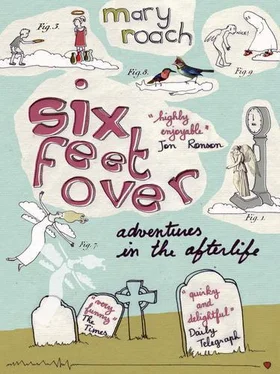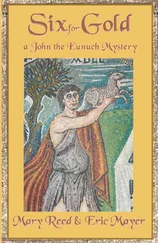“It combines great sensitiveness with the increase in capacity and platform,” said the proud Fairbanks copy. “Very handsome in appearance.” Indeed, as Macdougall had said, his scale was accurate to one-fifth of an ounce. I told Peggy the story of Macdougall and the dying consumptives, hoping she might have some nugget of Fairbanks scale minutiae that would explain the good doctor’s three-quarter-ounce drop. She initially wondered whether the platform might have been inlaid, in which case, you couldn’t have a cot sticking out over the sides of the platform without rendering the results, as she put it, “screwy.” But the scale in the drawing had a standard suspension platform.
“That’s about as far as I can take you,” said Peggy. You could hear the disappointment in her voice. Peggy Pearl could tell me what the weather was on April 10, 1901, and she could tell me what Carlton Felch was up to that day, but she could not tell me whether Macdougall’s cot contraption had somehow compromised the Fairbanks’s renowned accuracy.
MACDOUGALL SEEMED AWARE of his study’s weaknesses, and he encouraged others to try to extend and replicate his work. He wanted to do more trials himself, but was stymied by the earlier-cited frictions with officials. Overtures to “positioned and entrenched scientific authorities” at other facilities, he writes in a letter to R. Hodgson of the American Society for Psychical Research (ASPR), were met by rebuffs. His best bet would have been the ASPR itself. Indeed, the ASPR’s scientific officer, Hereward Carrington, upon hearing of Macdougall’s study, wrote at length and with great gusto, in an issue of the society’s journal, about the possibility of outfitting a condemned prisoner in an airtight glass hood, and placing him, electric chair and all, onto a platform scale.
In the end, Macdougall resorted to weighing some dogs on a scale he set up in his barn. Owing to the difficulty of finding dogs dying from a disease that rendered them exhausted and motionless, he immobilized and then killed them via injection—fifteen dogs in all. Not one evinced a drop in weight as it died. Macdougall’s spin on this rather striking batch of conflicting data was that of the churchgoing Christian: Animals don’t have souls—or anyway, sayeth the Bible, not the eternal variety—and therefore we should expect this.
Not everyone in the soul-weighing business would agree with Macdougall there. Ten years after the American Medicine paper was published, a physics teacher at Los Angeles Polytechnic High School self-published a book called The Physical Theory of the Soul , which included a chapter detailing his adventures in mouse-soul-weighing. H. LaV. Twining, as he appears on the title page, didn’t seem to like animals much, as we will see, but he gave them credit for arriving in this world with the same spiritual accoutrements as humans. “It is reasonable to conclude…” he wrote, “that all forms of life have accompanying souls… and that animals would form fit subjects… since they could be killed at will and under any chosen conditions, while human beings could not.”
Over the following four pages, H. LaV. offs thirty mice on his scale, using every condition the Polytechnic supply closet would support. He suffocated them in test tubes melted shut by Bunsen burners (no weight loss). He smothered them in flasks sealed with rubber stoppers and flasks sealed with parafinned corks (no loss, and no loss). He gassed them in open flasks with cyanide pellets. Here at last he witnessed a loss: one to two milligrams “at its last kick.” H. theorized that the poison had caused the mice to “perspire violently at death,” and that the lost milligrams were evaporated mouse sweat. I did a little reading on the subject of cyanide poisoning, in the form of a paper by Dr. John M. Friedberg, which helped prompt the Ninth Circuit Court of Appeals to deem cyanide executions cruel and unusual. Death by cyanide does appear to be moderately aerobic—panic, retching, seizures, violent head extension, grimaces—though excessive perspiration isn’t specifically mentioned as a symptom. Excessive salivation is, however. Perhaps some seizure-flung drool escaped the confines of the flask.
A colleague suggested that the lost weight might have been air expelled from the dying rodent’s lungs. No slouch, H. decided to test for this, too, a process he describes, with his characteristic flair for insensitivity, like this: “A mouse was thrown into a tank of water.” A test tube was slipped over the head of the drowning mouse to catch the air it expelled as it died, and this was weighed and found to be negligible.
H. quickly moved on to more pressing matters, such as the author of a book on Rosicrucian theory who had misstated some of H.’ s conclusions and misspelled his name. “This is inexcusable,” he crabbed. If humans, like mice, could be killed at will, I know just who would have been found in a tank with a test tube over his head. And along with him, the animal rights advocates who chastised Twining for his cruelty. (An account of his work had run in a local newspaper.) Here is Twining in defensive overdrive:
Nearly every person who reads these lines has suffered more from the tooth ache, a thousand times more, than any of these mice did in dying….
Even though suffering does not take place, there is no reason why dumb animals should not have their share of suffering. Human beings during a lifetime are subjected to hours, days, and years of mental and physical anguish inflicted upon them through no fault of their own….
The human family lives on the products of death…. We eat either animal or vegetable food and in either case life is destroyed…. To kill low forms of life is just as bad, if killing be bad at all, as the killing of the higher forms of life, and there is no need of becoming hysterical over it.
The point to take away from H.’ s work is that if you put a dying mouse in a sealed container—such that moisture, expelled breath, drool, et cetera, are trapped—its weight won’t change. So H. LaV.’ s work with mice is in line with Duncan Macdougall’s dog findings, neither showing evidence of a departing soul.
IN 1998, DONALD Gilbert Carpenter published a whole book about soul-weighing ( Physically Weighing the Soul ). It’s a long book but lightweight, as light as a soul, for it exists only in cyberspace, available by download at 1stBooks.com. According to Carpenter, the reason the dogs and the mice might have shown no weight loss at death is that their souls are so light they were below the scales’ detection thresholds. Macdougall said his dog-weighing scale was accurate to one-sixteenth of an ounce (1.8 grams), but a dog’s soul weighs less than 1.8 grams. How do we know this is the weight of a dog’s soul? Because Donald Gilbert Carpenter has calculated it. (I love this guy!) Using Macdougall’s findings for human beings—that the soul weighs about 20 grams—Carpenter calculated the ratio of soul-weight to body-weight-at-birth: 1 to 140. Applying this to a typical puppy birth weight, he deduced that the average dog soul weighs one gram—about half the 1.8-gram sensitivity of the scale. Same problem with Twining’s mouse souls—too light to register. (But not Jesus’ soul. The discarnate Jesus is calculated in Chapter 17 to weigh 364 grams—close to a pound!)
Elsewhere, Carpenter calculates the volume of the human soul—or Mac, as he prefers to call it, in honor of Duncan Macdougall. Here is how he came up with his volume amount. The smallest infant to survive at birth, he says, weighed ten ounces and had a volume of three-tenths of a quart. (I do not know the formula for calculating the volume of a premature baby; perhaps he hired H. LaV. Twining to throw one into a graduated cylinder and note how much water it displaced.) The volume of the baby’s Mac would be identical to its birth volume because, quoting Carpenter, “if the volume of its… Mac had been bigger than that, it would have stuck out of the child’s body.” Once again, Jesus is the exception. His Mac had a volume of 5.25 quarts, meaning that half a quart’s worth of excess soul stuck out of his body when he was born. Carpenter surmises the protruding material took the form of a glow, rather than the more pedestrian hump or goiter that leapt into my mind.
Читать дальше











